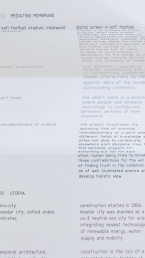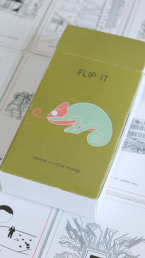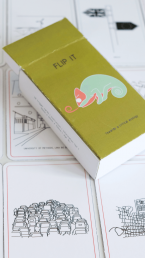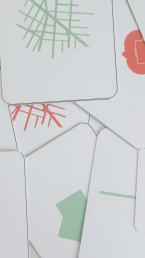FLIP IT, Towards a Critical Ecology
Leonie Link & Nikolaus Stiefler
Flip it is an invitation to flip cards, flip mental models, and flip systems.
The game invites the players to figure out relations between seemingly different ideas to develop another level of information. The association process would trigger an internal conversation or a conversation with others. With more images and less text, the interactive card kit attempts to work beyond restrictions of spoken languages and disciplinary languages, allowing the players to find a common form of communication to discuss the idea generated in relating the cards. The players can respond performatively by sketching, by creating a response to the two cards as freely as possible.
Read More
The card kit is inspired by a close reading of Maldonado’s idea on closed systems and open systems (as appropriated from von Bertalanffy) and related notions of conservation and coevolution of ideas within systems. The two levels of information in the interactive system attempt to address the values frameworks associated with conservation and coevolution. The first layer, a set of time-bounded(the 1960s, 2020) concept cards, attempts to conserve the idea’s socio-political relation to its time. For those who are playing to learn about the 1960s periodized discussion by Maldonado, this allows understanding the historical framework of his ideas. The second layer of information is what the user creates by associating the current information, which can be in any form, image, text, proposal, a provocation, etc. A variation is available for opening up the game to anyone who wants to replace the card and update the card set with critical ecological issues that will appear in the future, making the game evolve to something utterly different in its players’ hand. The free play approach emphasizes the value of continuously updating the discussion on ecology and bringing forth other value frameworks and contexts necessary to the players.

CONCEPT
This card game is based on the work of the designer TOMÁS MALDONADO, especially his book “DESIGN, NATURE & REVOLUTION- towards a critical ecology”. The card game works as an open system: It offers associations related to six of Maldonado ́s main concepts about critical ecology within different periods of time. Through blank cards it allows an interaction and asks the players to express their own ideas on the offered inputs. The card game is a mediating membrane: It connects Maldonado ́s ideas to critical ecology, the history to the present and external information to internal associations. It is a tool for transdisciplinary thinking and creating a complex system of interrelations to work on ecological design questions.
COMPONENTS
The card game is a set of 48 trigger cards and 24 blank cards (to be prepared) The trigger cards are split in different time periods, each marked in another colour. The starting version of the game consists of trigger cards from the 1960th and the 2020. additional periods need to be marked in a new colour and registered in a list. There are six main concepts, each split in four subtopics, prepared for the different trigger cards. These concepts are marked through a symbol on the backside of the card and the colour related to the time period they belong to. On the frontside of the cards there is a drawing of an input and a description. You can find some background information about each of the drawings on the frontside of the card in a list, which also is an (open)archive, to which players can add information.
STRATEGY
The simplicity of the card game allows various possibilities of play to be used with different intentions, ranging from a fun kit to a knowledge kit.









